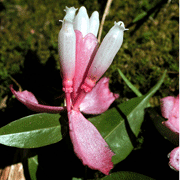James L. Luteyn and Paola Pedraza-Peñalosa
The New York Botanical Garden
|
|
Cavendishia is a neotropical genus of about 150 species ranging from Mexico (Oaxaca), south through montane Central America to Bolivia, and east through the Guianas to Brazil (Amapa). It may be easily recognized by usually large, brightly colored floral bracts and by stamens with alternately unequal filaments and anthers. |
CAVENDISHIA Lindley, Bot. reg. 21: pl. 1791. 1836
(1835?), nom. conserv.; Luteyn, J. L., Fl. Neotrop. Monogr. 35: 1-290.
1983; Luteyn, J. L., Fl. Ecuador 54: 68-110. 1996. Type: Cavendishia nobilis Lindley.
?Chupalon Adans., Fam. pl. 2: 164. 1763. Type: not designated.Socratesia Klotzsch, Linnaea 24: 22. 1851. Type: Socratesia melastomoides Klotzsch.
Polyboea Klotzsch, Linnaea 24: 24. 1851, non Klotzsch ex Endlicher (1850=Euphorbiaceae). Lectotype: Polyboea laurifolia Klotzsch.
Proclesia Klotzsch, Linnaea 24: 32. 1851. Lectotype: Proclesia cordata Klotzsch.
Erect shrubs, evergreen, epiphytic or terrestrial;
bark thin, cracking longitudinally; bud scales not stipular.
Leaves alternate, simple, estipulate, plinerved or pinnate, coriaceous,
marginally entire and revolute, both surfaces usually with multicellular,
reddish or blackish, slightly sunken, glandular trichomes to 0.2 mm long,
if glabrescent appearing punctate. Inflorescence axillary, racemose
or subfasciculate, usually solitary, encircled at the base by a progression
of bracts, the smallest bracts minute and triangular, the largest conforming
to the shape and size of the individual floral bracts, the inflorescence
bracts few to numerous, imbricate, coriaceous, smooth or minutely striate
or muricate, marginally scarious and usually minutely glandular fimbriate;
floral bracts solitary at base of pedicel, caducous or usually persistent,
usually large and showy; pedicel cylindric, bibracteolate near the base
or rarely midway up the pedicel; bracteoles chartaceous or coriaceous,
basal or rarely midway up the pedicel, usually glandular. Flowers
5-merous, without odor; aestivation valvate; hypanthium articulate
with pedicel, fused with the ovary wall, basally expanded into an apophysis
or not, constricted at the base of the limb; limb erect or spreading,
free from the ovary wall, 5-lobed; lobes erect or connivent after
anthesis, usually glandular; corolla
tubular, usually carnose when fresh, 5-lobed, the lobes valvate or
conduplicate valvate, usually flaring at anthesis; stamens 10, subequal
or rarely unequal, subequalling the corolla, lacking spurs; filaments
ligulate, usually distinct, rarely slightly coherent at the extreme base
at anthesis, alternately unequal, shorter than anthers; anthers alternately
unequal, lacking disintegration tissue; thecae smooth or slightly
granular; tubules about the same width as the thecae and about twice
as long, flexible, dehiscing by introrse, elongate clefts; pollen
without viscin threads; ovary inferior, 5-locular, surmounted by
a flat or cupuliform nectariferous disc; style filiform, straight
or sigmoid, usually glabrous; stigma minutely 5-lobed, truncate but
slightly flaring at anthesis. Fruit a juicy, spherical, dark blue
black berry; seeds many, minute, 0.5-1 mm long, the testa foveolate.
Key to Neotropical Species Back to Top
A key is coming soon.
This electronic taxonomic treatment of the genus Cavendishia is incomplete at this moment, lacking a full introduction and complete key. The reader is referred to the published account of this genus in Flora Neotropica Monograph 35: 1-290 (Luteyn, 1983), which deals with the 100 species known at the time.
